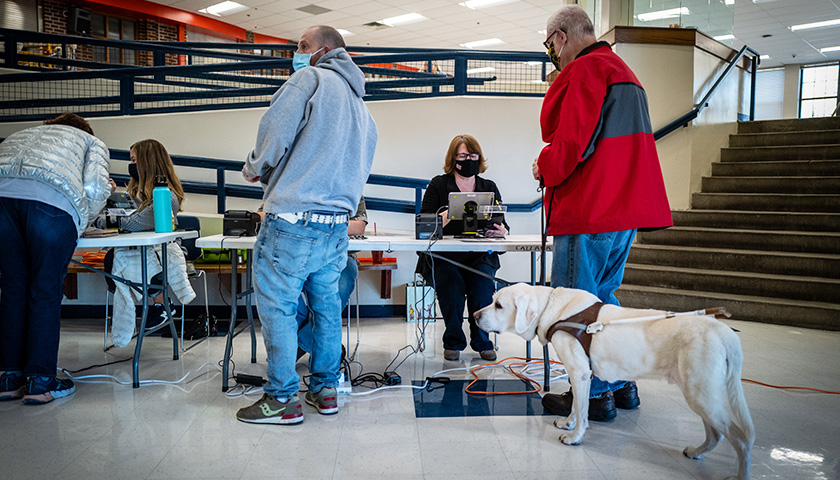by Richard Benedetto
Regardless of all that wispy smoke Democrats and their allies in the news media are blowing, key polls suggest Republicans are still likely to win back control of the House of Representatives in Tuesday’s midterm elections and have a better than even chance to take over the Senate.
Historically, one of the strongest indicators – perhaps the strongest indicator – of how a party will do in midterm elections is the job approval rating of the incumbent president. Parties of presidents who are down in the polls usually lose congressional seats. Parties of presidents up in the polls generally gain seats in the midterms.
In other words, how a president is doing a reliable predictor of how Americans will vote in congressional elections.
The latest October Gallup Poll has President Biden’s job approval at 41% among registered voters. Among voters dissatisfied with how things are going in the country, three of four disapprove of Biden. With numbers like that, most Democrats on the ballot should be running scared.
Key indicators suggest Americans are in a sour mood over a slew of issues.
COVID and its disruptions of everyday life still have people anxious. High cost of groceries, gasoline, and mortgages are straining family budgets. Rising crime and murder rates in cities have people fearful. And the relentless tide of illegal immigration at the southern border poses serious physical and financial challenges to communities struggling to absorb migrants.
Moreover, increasing battles over falling education test scores, what should be taught in schools, abortion, climate change, and gender wars show no signs of abating, and overseas turbulence and war in places such as Ukraine, Russia, North Korea, and China pose serious security threats.
Traditionally, when voters are not happy – and just one in four say the country is moving in the right direction – they are likely to take it out on the party in power. That would be the Democrats.
Democrats currently hold a slim 221-212 margin in the House of Representatives. The Senate is a 50-50 tie, with Vice President Kamala Harris giving Democrats control by virtue of her tie-breaking vote. Thus, history and conditions, along with Biden’s low approval ratings, are on the GOP’s side as they seek to regain control.
Looking back at how the party of presidents with job approval numbers in the 40s or lower performed in recent midterms, there is little to give Democrats comfort:
- In 2018, President Trump’s job approval rating was 41%. His Republican Party lost 40 House seats in the midterm, ceding control to the Democrats.
- In 2014, President Obama’s job approval was 44% and his Democratic Party lost 13 House seats.
- In 2010, Obama’s job approval was 45% and Democrats lost 63 House seats and the majority to the Republicans.
- In 2006, President George W. Bush’s job approval was 38%. The Republican Party lost 30 House seats and its majority to the Democrats.
- In 1994, President Bill Clinton’s job approval was 46%. The Democratic Party lost 53 House seats and lost majorities in both the House and Senate to the GOP.
- In 1982, President Ronald Reagan’s job approval was 42%,.The Republican Party lost 26 House seats.
Over the past 40 years, the incumbent president’s party gained House seats in just two midterm elections. In both cases, the presidents had high job approvals ratings:
- In 2002, in the aftermath of the 9-11 attacks, President George W. Bush’s job approval stood at 63%. The GOP won a net of six seats.
- And in 1998, in the middle of the House impeachment hearings over the Monica Lewinsky affair, Clinton’s job approval was 66% and the Democratic Party gained five House seats.
But in 2022, Biden’s job approval is more than 20 points lower than those of Clinton or Bush, a major handicap for Democrats. So, what can Biden do to gain Democratic votes? His debt forgiveness plan for student loans helped lift his support among 18-29 voters from 31% to 40%, but still far below the 60% he won from young voters in 2020.
According to the latest Gallup Poll, Biden does best with women – 51% approval. That number jumped up from 45% before Roe v. Wade was reversed, suggesting that the Supreme Court’s decision to nullify the right to abortion has helped increase female support for the Democratic president.
First lady Jill Biden has been campaigning hard for weeks to raise money for congressional Democrats and increase support among women voters. Last Sunday, she headlined a fundraiser for Democratic Rep. Sean Patrick Maloney in Mt. Kisco, N.Y. On Wednesday, she was set to appear at the nationally televised World Series in Philadelphia to highlight its “Stand Up to Cancer” observance.
Other groups that give Biden more than 50% support are blacks at 63% and Hispanics at 53%. They too are being targeted.
On Tuesday, Biden made a pitch for black votes when he spoke via phone to nationally syndicated radio host Rickey Smiley. The president touted his efforts to advance equity and opportunity for African Americans and stressed the importance of voting, particularly for minorities. Biden also highlighted expunging police records for marijuana violations, student debt relief, increased aid to Historically Black Colleges and Universities, and his appointment of Ketanji Brown Jackson, the first black female justice of the Supreme Court.
On the other hand, Biden’s approval among whites, the largest voting bloc, is just 35%, and among men of all groups, approval stands at 32%. The president has a lot of work to do to bring those numbers up in the final days of the campaign. If he falls short, history will repeat itself.
– – –
Richard Benedetto is a retired USA Today White House correspondent and columnist. He now teaches political science and journalism at The American University and in The Fund for American Studies program at George Mason University.




